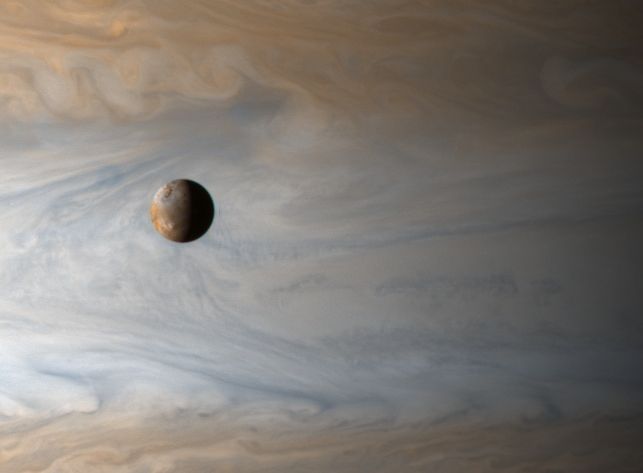

Cassini image of Jupiter, with its moon Io in the foreground. Image Credits: NASA, JPL, University of Arizona.
A short introduction to astronomical coordinate systems and the
apparent motion of celestial objects, as well as quizzes to test your
knowledge, are available at Jet Propulsion Laboratory's Basics of Spaceflight page.
See section 1.2 for the material on reference systems.
Try this exercise using the Naval
Observatories Local Sidereal time clock
to help get a better feeling for the differences between solar and sidereal
time. You will probably want to have 2 browser windows open to do this, one
to for the instructions, and the other for the LST clock. Having trouble understanding the causes of the seasons, or the difference
between mean solar time and apparent solar time? Try the Analemma web site
(an analemma is the path that the noontime sun
traces on the sky over the course of a year) to try to get a better
understanding of how the tilt of Earth's axis and elliptical shape of the
Earth's orbit cause the Sun to vary its position on the sky with time.
To learn more about the calendars used by different people, take
at a look at the "calendar converter" page at
Fourmilab. To get to the page, select
"Astronomy and space" from the left-hand frame, and then in the right-hand
frame select "Calendar Converter". The page has a discussion
of many different calendars, and also has a calendar calculator, that allows
you to convert between the Gregorian Calendar that we commonly use and
other calendars. If you thought there was something particularly special
about January 1, 2000, try entering that date for some other calendars and
see if that date corresponds to a nice round number on other calendars.Orbits and Newton's Laws of Gravity and Motion
See JPL's Basics of Spaceflight
page (sections 1.3, 1.4, and 1.5) for a discussion of Newton's laws, and
their application to the orbits of objects in the solar system.
The Nine Planets. This site is the best compilation of informaest compilation of information on the planets and other solar system items that I have seen.
Another very good site is Jet Propulsion Laboratories Welcome to the Planets page.
To get a better understanding of comparative planetology, try the comparative planetology exercise at the University of Washington's Astronomy 101 clearinghouse . Follow the Labs link on this page to find the exercise.
The National Solar Observatory at Sacramento Peak has a nice home page. They have down loadable Solar images, as well as lots of information about the Sun and Solar phenomenon. In addition if you have any questions about the Sun, you can "Ask Mr. Sunspot".
The Big Bear Solar Observatory, which is run by the New Jersey Institute of Technology, puts daily full disk white light pictures of the Sun on line.
A good introduction to the Sun and its properties is the High Altitude Observatories education page. Especially check out "The Sun: A Pictorial Introduction" slide set, and the "Visit the Solar Interior" image map.
What properties of the solar syst What properties of the solar system must any successful theory of the formation of the solar system be able to explain? Go through the Formation of the Solar System 2.0 at the University of Washington's Astronomy 101 clearinghouse , and see for yourself. Follow the Labs link on this page to find the exercise.
Back to the main UH Astronomy Courses page.
Send Page maintainer email: vandersen@uh.edu